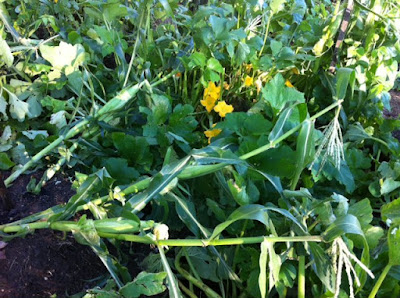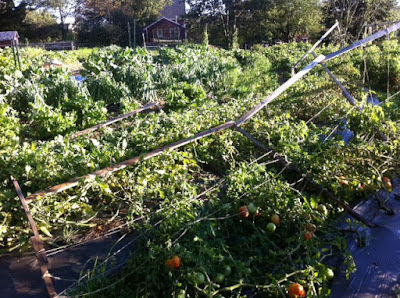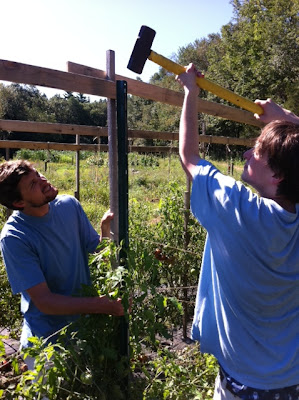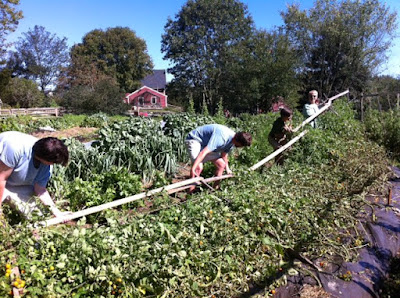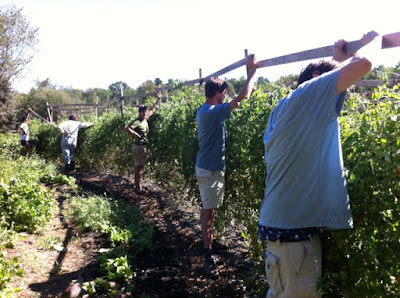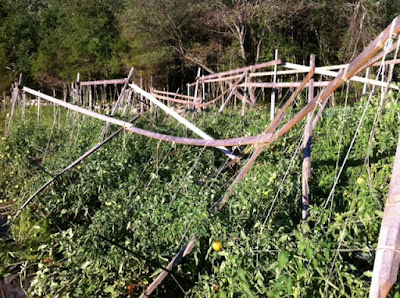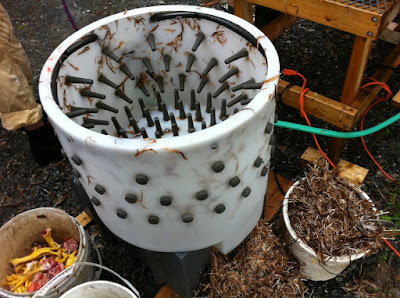Hasso Ewing (lead grower at BBFg):
It is hard to believe it’s the middle of August and this is the first time I have contributed to
this blog! The garden is at it peak, the pigs are joyfully chomping on a new field of Sudan
grass, chickens are fattening up, while others continue to lay faithfully. The middle of the
summer, the point at which we are drawing the most from the earth by growing plants
and animals.
This piece of land we have come to farm has been very productive. Partly
because it abuts a wet meadow and because it’s aspect is southeast. It hadn’t been
farmed for more than 20 years and even then it was likely just animals, not vegetables.
It’s deep and organic in nature, lots of decomposing plant material, as opposed to
mineral (rocky or sandy) soils. It holds water like a sponge , consequently we haven’t
had to rely on irrigation, thus far.
Our proximity to the wetland brings in insects, dragonflies and butterflies. Our
tomato trellis may not have been strong enough to handle the weight of the many large
fruits, but the trellis did support the landing site for many fledgling barn swallow clutches
out on their first flight. Bluebirds, too, used the wooden posts to hunt for early spring
bugs.
The electric fence that surrounds both the vegetable patches, the pigs and the meat
chickens protects our charges from animals that would also like a local source of fresh
organically grown food. Dave did his homework on the best fence plan for our site. Our
fences aren’t high (2 ½’) but they were baited with peanut butter. Apparently, most
animals like peanut butter and will go for the PB before they jump in for the animals or
vege. But when they lick the PB on the foil, hanging over the electric fence, they get a
shocking response! Happens once, they don’t come near again and what’s more, they
tell their family and friends. So, we have been lucky, again… thus far.
We have experimented with walkway management to lessen weed pressure and
increase soil fertility. Some rows are cardboard from the bike shop (nice big pieces) with
old hay from Concord DWP projects on top. We planted white clover in others and then
mowed when weeds were topping the clover. That gives clover the advantage and it
takes over. We brought in compost for seeding and transplanting in the rows from a local
farm and amendments (rock dust, mycorrhizal organisms and seaweed mixes) from
away. We decided to use some plastic as mulch in the rows, as much as I hated to. The
area closest to the wetland would have been weed hell if it were not for black plastic
mulch. That’s under the tomatoes, eggplants, peppers and squash. They love the extra
heat and moisture retention plastic offers. We also use row cover, which is spun plastic.
That protects our plants from pests without using pesticides.
We are growing our plants and animals organically and, if we choose, could get
organic certification pretty quickly, I imagine. Generally, you have to transition over a
period of 3 years to organic because the land has to be cleansed. But since this land
hasn’t been farmed for so long we could prove it’s clean enough.
Organic, natural, and eco-ganic would describe our farm. Organic, because we
don’t use any chemically (man-made) fertilizers, herbicides or pesticides and we follow
national organic standards, but are not ‘certified organic’.
There is ‘certified natural’ being used now in the US. It has been around for a
while in other countries but now some American farmers are using natural certification in
response to organic certification. Organic certification policies are very difficult for the
small farm to adhere to. They are lengthy, expensive and the record keeping
requirements are over the top. Natural certification has a $75 annual fee, has far less
unnecessary reporting and uses peer review to oversee standards. This review process
is a nice aspect because it is bringing local farmers together.
Then there is eco-ganic. Eco-ganic is defined by Potomac Vegetable Farm as a
process by which a farm maintains rich organic soils, full of beneficial microbes, to
provide the crops with sufficient nutrients and a healthy environment. The farm can’t use
any synthetic fertilizers or pesticides, they rotate crops, grow many different kinds of
crops, and use timely and appropriate practices to try to minimize insect and disease
damage. The idea is to manage the soil and cultivate the crops in ways that will allow
the land to continue to be productive now and into the future. I actually like this label the
best. It’s about the mind blowing interaction of so many parts (soils, insects and animals,
water, sun) coming together and undertaking a amazing cycle of growth, death,
decomposition and regrowth and, we as participants, help perpetuate that cycle into the
future.
All three of us (Gallagher, Dave and myself) have been committed to maintaining
the healthiest environment for our products, whether they be plant or animal. We want to
eat responsibly grown food, food that is high in nutrients and free of damaging
chemicals. Black Brook Farm Growers may not have the organic stamp of approval from
big business, but we are bringing to market products that are as good or better for our
customers than what they buy from most other currently available food sources.
Now, in the full belly of August, we change much of our focus from planting to
harvesting and storing. Growth has peaked and days shorten. We will harvest the food
from our plants and animals and return to the earth that which we don’t use., helping to
replenish what we have taken.
And, if time allows (I am on vacation today), I will write again about our adventure
into farming on a small scale biodiverse farm in New England

